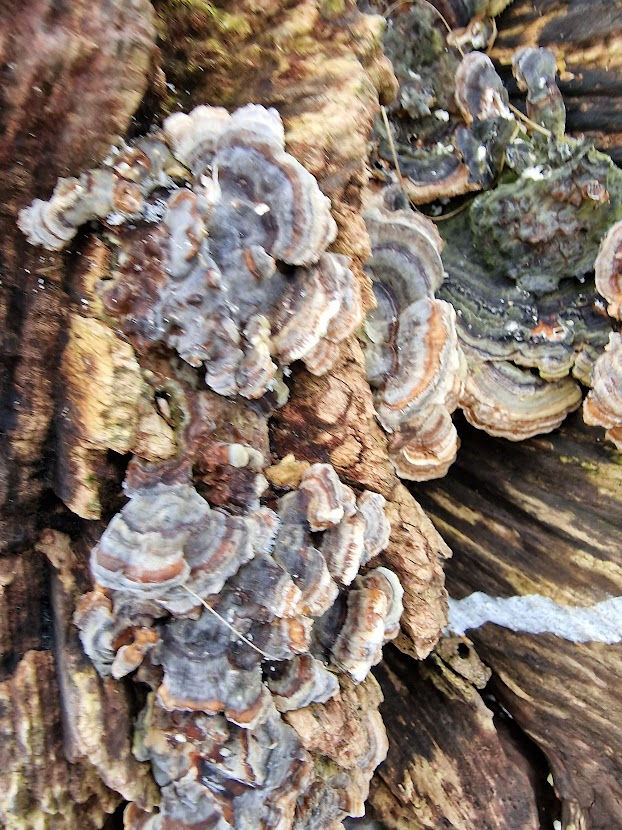Lichens, Bryophytes, Fungi and Birds. Waterhall Nature Reserve & The Devil's Dyke. 23.01.23
- Sim Elliott

- Jan 26, 2023
- 4 min read
Over the weekend a local lichenologist saw a String of Sausages, Usnea aticulata, following a fellow member of the British Lichen Society identifying it (and a Telioschistes chrysophthalmus, another rare lichen) and telling me where they were. I was very excited to hear of their existence in this location as they are rare species in the South East. As I had had a positive lateral flow covid test result 7 days ago, I walked from my house to the Devil' Dyke. I heard of the sighting when I ending the five days of recommended self-isolation, but I am solely a public transport user, I didn't want to go on a bus until 10 days after my positive lateral flow test, as the government advises not having contact with vulnerable people in 10 days, and a lot of vulnerable people use busses. From my house to the Devil's Dyke is 7 miles - but when you get to the edge of Brighton is a beautiful walk from my house through Coney Woods, Green Ridge, and Waterhall Local Nature Reserve.
Coney Wood and Green Ridge
Coney Wood - Woodland Trust Coney Wood covers a fairly steep hillside between the A23 at Patcham and Green Ridge.
Probably Snowy Disco. Lachnum virgineum, on the earth "risers" of the wooden steps in Coney Wood


Hairy Curtain Crust, Stereum hirsuitum on a dead trunk; a very common fungi on dead wood in Sussex.

Rough-Stalked Feather-Moss, Brachythecium rutubalum

Waterhall Windmill
Waterhall Mill was built in 1885 by James Holloway, the Shoreham millwright. It is a four-storey brick tower mill with a domed cap winded by a five-bladed fantail. It had four Spring Patent sails. Waterhall Mill, Patcham - Wikipedia

Waterhall Nature Reserve
Waterhall Nature Reserve, was formerly a Brighton and Hove City Council golf course. It has been left to auto-rewild, with some conservation grazing from ponies, see: Wilding Waterhall. I stopped at Waterhall as I knew that rare Teloschistes chrysophthalmus have been seen there, but I couldn't find any.
There are many individual and small groups of Hawthorne tress at Waterhall, as there are on many South Downs dip slopes and in hedgerows. These Hawthornes were covered in lichens including Lecidella elaeochroma, Ramalina farinacea, Ramalina fastigiata; Xanthoria parientina
Usnea ceratina Warty Beard Lichen

Detail

Ramalina fastigiata and Xanthoria parientina on Silver Birch



Wind-bent Hawthorns on the way to the Devil's Dyke - a characteristic sight on the Downs

The footpath I took to the Devil's Dyke may not have been the best path to take

Cypress-leaved Plait Moss, Hypnum Curpessiforme - one of the most common mosses on trees on the Downs

Entering the National Trust's Devil's Dyke estate.

It was very icy in the Dyke

Buzzard - I frequently see Buzzards hunting over the Dyke

Ice crystals on dead wood

Turkey Tail, Trametes versiclor, on a log in the Dyke

King Alfred's Cakes aka Coal Fungus, Daldinia concentrica

The connection between King Alfred’s cakes, humans and fire goes back much further than the legend of King Alfred.
During the archaeological excavation of a 7,000-year-old Spanish settlement, the fungus was found gathered alongside different ‘tinder’ fungi. In other words, the people living there had likely foraged them to help light their fires.
Traditional methods of creating a spark, such as hitting flints together or creating friction between pieces of wood, are enough to ignite the dry fruiting bodies of King Alfred’s cakes.
These can then be used as kindling to start a fire. This explains other common names used to describe the fungus such as ‘carbon balls’ or ‘coal fungus’.
This traditional practice is well known in recent human history, shared by word of mouth. But this discovery shows it could be traced right back to the Stone Age.
Once lit, the fruiting bodies can smoulder gently for a long time, leading to the speculation that prehistoric people could even have used the fungus to transport fire when moving between places, a powerful survival tool. Meet the firestarting fungus | Kew
Orbilia xanthostigma (possibly)


String-of Sausages Lichen, Usnea articulata
This species was very sensitive to sulphur dioxide pollution and declined in the 19th and 20th centuries. It ... is showing signs of recovery subsequent to declines in sulphur dioxide pollution, especially in south Wales. British Lichen Society Usnea articulata
Whilst it is recovering in the West, particularly South Wales, this is an unusual lichen in the South East




Walking through Saddlescombe back to Brighton
Bitter Oysterling, Panellus stipticus

A drovers' way

In the drovers way:
The liverwort, Flat Neckera, Alleniella complanata,

and
In lowland England it is most often found on the base of ash (Fraxinus excelsior) trees in ancient woodland or around the base of beech (Fagus sylvatica) and ash on chalky banks Radula complanata - British Bryological Society

Roots!

Lichen on moss - both to be identified.



Further down the Sussex Borders path on the way to Waterhall I saw this lichen on a fencepost. The pink was very noticeable in the overcast afternoon. The lichen is Parmelia sulcata but it may be infected with the pink lichenicolous fungus Marchandiomyces corallinus. Requires further exploration.




On the post of a gate

Ramalina farinacea at Waterhall - a very common lichen.




Comments